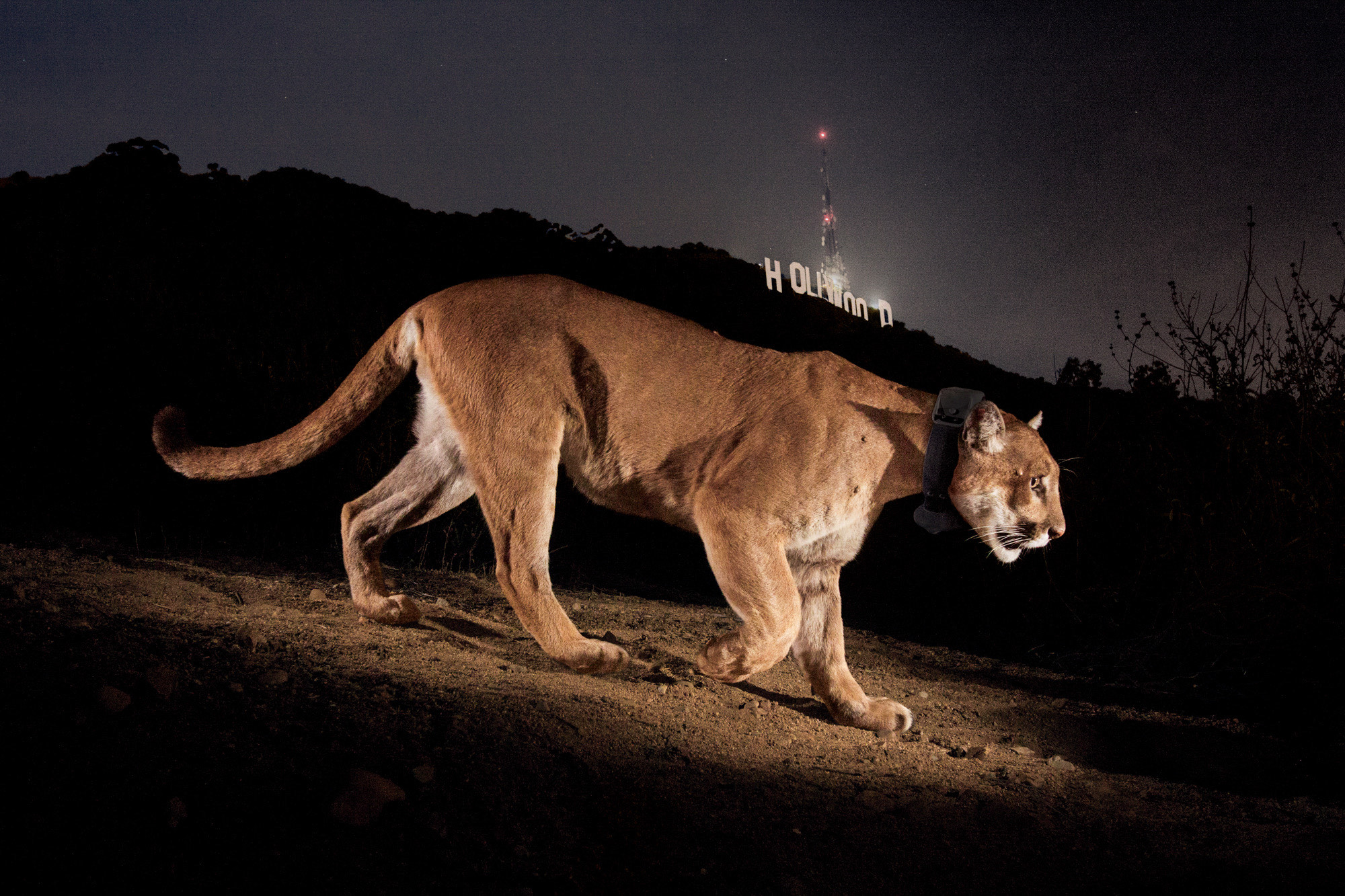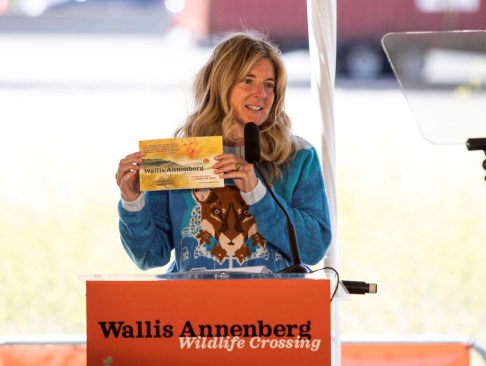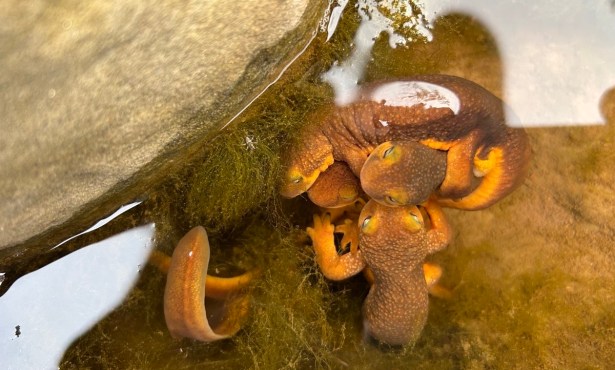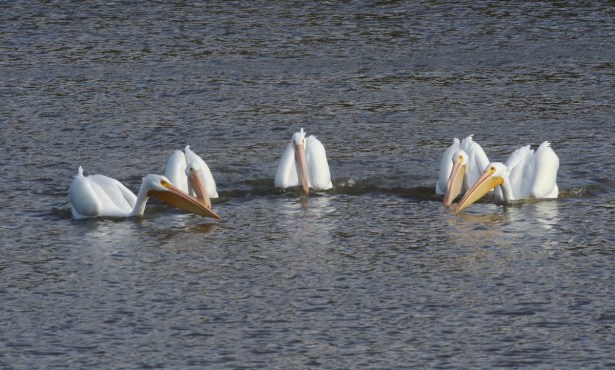The Mountain Lion that Changed the World
Beth Pratt Talks P-22, His Legacy, and His Role in Building World’s Largest Wildlife Crossing in California

P-22 — the first mountain lion to successfully cross the 405 and 101 freeways in Los Angeles and to survive for many years in the city’s Griffith Park — became a celebrity and an inspiration in his lifetime and has left behind a historic and impactful legacy. He lived under the Hollywood sign, after all.
His name came from being the 22nd puma in a National Park Service study, but his story is much more heartwarming, and personal.
To Beth Pratt, the National Wildlife Federation‘s regional executive director for California, P-22 was relatable. He made people see wildlife as neighbors, as creatures with struggles not so different from ours. “We are part of nature, and he reminded us of that,” she said.
Pratt has led the #SaveLACougars campaign in P-22’s memory, leading to the construction of the Wallis Annenberg Wildlife Crossing, a project that will connect a crucial wildlife corridor and help protect a local population of mountain lions from extinction. It will be the world’s largest wildlife crossing and the first of its kind in California.
The Independent sat down with Pratt ahead of her July 31 talk, The Life and Legacy of P-22, at the New Vic Theater, as part of Santa Barbara Wildlife Care Network’s Wild Talks lecture series. If you want to know the answer to “Why did the cougar cross the freeway?”, read on.
How did P-22’s story inspire you? I first read about the story of P-22, like most people, in the L.A. Times in 2012. At first, I didn’t believe it. “Fake news” was not a term at the time, but if it had been, I probably would’ve used that. I was just so incredulous that a mountain lion could be making a home in the middle of L.A. like that.
But I’ve been working with the Park Service for most of my career. So I contacted the biologist Jeff Sikich, who collared P-22. He was gracious enough to take me out for a day, to walk around Griffith Park. I was just blown away.
Although I’ve been in California now for 35 years … I worked in national parks, places like Yellowstone and Yosemite. So that was my idea of where wildlife should be — these vast wild places, untouched land. So to walk around Griffith Park and be like, “Oh, my God, this mountain lion is making it here?” I just couldn’t believe it.
When Jeff told me what P-22 had to do to get there — he actually drove me along the route of crossing two of these major freeways to find a new home — I just felt like we had to do something. If these mountain lions were hanging on, despite all the odds, the least we could do is try to help them. I asked how I could help.

Jeff answered, “There’s this little wildlife crossing we’ve been trying to get built.”
I very naively said “Sure!” not knowing it would be a decade of my life and a $100 million project, but it was just a moral imperative.
This cat had made this miraculous, wondrous journey because he had to, and he was coexisting with us just fine.
A psychologist friend of mine calls him a “relatable victim,” and I think for a lot of people, he’s pretty relatable. That’s why he resonated with me at the time. I mean, who in Southern California can’t relate to the 405 being a challenge? Nobody wants to cross the 405 divide.
In some respects, P-22 was isolated his whole life. Once he got to Griffith Park, I’m sure he didn’t want to leave because getting there was so terrifying and dangerous. He maybe thought, “I might not live through it again.” So he made it work in Griffith Park, although that wasn’t usual for a mountain lion. For me, I think, we owed him.
I’ve done his likely route on foot over a dozen times now, I can’t believe I’m still alive. I’ve stood on the 101 at 2 a.m., and I still wouldn’t dash across — you couldn’t pay me a million bucks. … What a remarkable cat.
Have miraculous urban journeys become more common for wildlife? Is it more common? Or do we just have social media, or does everybody just have a Ring cam now? We now know what is in our backyard.
However, yes. I think animals are trying to reclaim spaces we banished them from. Where I grew up in Massachusetts was sort of suburbia … and the best I could hope for, seeing wildlife, was birds and frogs and squirrels and a turtle and maybe an occasional snake. Everything had been hunted or banished.
Now, if you go back to that neighborhood, there are deer, bobcats, and coyotes. I think that we, for so long, were either hunting animals to extinction, at least locally, or treating them as pests. That attitude, I think, has changed across the U.S., like, maybe we can share our space. I think P-22 is probably the best example of that. The animals are coming back on their own, which is good. Hopefully, we can learn to share that space.
Sign up for Indy Today to receive fresh news from Independent.com, in your inbox, every morning.
Did you meet any resistance to the wildlife crossing project? The lucky part for me is we were doing this in California. … Since 1990, we’re the only state in the country where you cannot sport-hunt mountain lions. So, it wasn’t the heavy lift it might have been elsewhere.
We still had opposition, but it was really just individuals; there was no concerted opposition. There are just some people who don’t want to live with predators, even if you tell them that driving your car is much more dangerous.
We try to help educate people that these mountain lions, bobcats, and coyotes are not waiting in the woods ready to attack us. I mean, look at attacks in California with mountain lions: Your stepladder is more dangerous than them.
I think the other opposition was just: “Why would you do it here; it’s an urban area; who cares if wildlife should be here?” As well as the cost. Around $90 million, Caltrans is estimating, seems like a lot of money. But when you look at the costs of construction, and what it costs to build a bridge in California, it’s a pretty reasonable amount of money to reconnect a landscape for generations and to keep wildlife on the landscape.
Can you tell me more about making this crossing come to life? We should be finished at the end of 2025. I have to say, after working on this for over a decade now, to drive by it and see that the concrete pillars are going up to support the overall structure, I get emotional every time I drive by the construction site or stop and talk to the construction workers. It’s incredible to see it go up.
I think of that time in Griffith Park; this started in 2012. So, 11 years of my life. It took over my life. It’s a sort of a cliched saying, but it really did take a village. …
[P-22] inspired this project. Scientific papers don’t build wildlife crossings. It is the political will and the public will, and so you need both; you need the science, but you need to capture the public’s imagination as well. And I think that’s what P-22 did. He showed people what it meant to be a wild animal in a very humanized landscape and how tragically hard that was. He inspired people to rethink how to live with wildlife, and what’s possible, and he elevated the public awareness of wildlife crossings across the world. I mean, not bad for a little small-town cat, right?
How did P-22’s death, after being struck by a car last year, affect you and the efforts toward this wildlife crossing? It was really hard. … I sat in a room for an hour with some of the top vets and wildlife officials in the country, especially on big cats, and we were all in tears. …
Euthanasia was the only compassionate alternative; he was just going to continue to get worse.
It was a really hard decision. You had wildlife officials, like the head of Fish and Wildlife Chuck Bonham, literally in tears when announcing this. I got to sit with him and P-22 the day before they put him down.
I got to talk with P-22 and tell him he was a good boy, and that he really changed things for us, and that I was sorry I couldn’t help him. I never felt so helpless in my life. It was great to finally meet P-22, although it was such tragic circumstances. He just sat with me for a while, and it was pretty profound. I just wish I could have done something for him, you know?
Well, you kind of are doing something for him through the campaign, through championing this wildlife crossing, right? Yeah, when I sat with him, I told him I wouldn’t stop, and that we were finishing up the crossing to help save his kind, and we want to do more. We just want to make sure we honor his legacy, and make sure that no more animals have to suffer the way he did. Although he made it work, he was, in the end, doomed by those roadways.
Why should Santa Barbara be willing to undertake similar initiatives for our local wildlife population? There are different answers to “Why?” Why should we help wildlife? Why should we coexist, even when they eat our pets? There are different layers to that answer. For a lot of us, it’s just that it’s a value that we love living among these marvelous creatures, whether it be mountain lions or butterflies.
There are also moral arguments. They were here first; we are the ones who displaced them. We have a moral obligation to make space for them and to do what we can to help them be successful. …
There’s also a self-interest here, playing out with climate disruption. We’re messing with the environment in ways that have consequences for our own well-being. And wildlife is a big piece of that; there’s a lot of science around how top predators on any landscape, like mountain lions, really do have a lot to do with the health of the environment. …
We have a lot of supporters for the Wallis Annenberg Crossing from Santa Barbara, and there are other crossings needed in the Santa Barbara area, like along the coast. But I think most people live in Santa Barbara because they love the natural landscape, whether it be the ocean or the wildlife that you’re surrounded with. So I think most people in Santa Barbara would agree that we need to do what we can to keep wildlife on the landscape because it’s one of the things they value about living there.
Most people, no matter where they live, love knowing that there are wild animals still here. I meet very few people who, if a bald eagle flies overhead, don’t stop and pay attention. There is something still in us that really values seeing these wild animals and having them in our lives.
What do you think is the future relationship between local humans and wildlife populations? We’re connected. I think we, humans, have sort of distanced ourselves. There’s wildlife and us, animals and us. Well, we are animals; we have the same natural laws that apply to us. I think we need to get to this “we’re all in this together” mode of thinking rather than thinking wildlife is lower than us, or we’re not a part of this incredible natural world, because we’re seeing the consequences of that thinking.
The Life and Legacy of P-22 lecture with Beth Pratt will take place on Monday, July 31, from 6-8 p.m. at the New Vic Theater in Santa Barbara. To purchase tickets, see etcsb.org.




You must be logged in to post a comment.